Utopias on Paper, a fascinating selection of 20th century graphics by leading German Expressionist artists active before and during World War, marks the opening of the new Prints and Drawings gallery at the Tel Aviv Museum. This show, curated by Irith Hadar, features drawings, woodcuts, etchings, engravings and lithographs selected from the Museum’s mammoth collection of German expressionist prints. At its core are some 1,500 items brought from Berlin in the early 1930s by Dr. Karl Schwartz, curator of the Berlin Jewish Museum, who became Tel Aviv Museum’s first chief curator.
The fundamental aim of these Expressionist artists was to create a new mode of artistic expression which would form a bridge between the past and avant-garde movements of their time. Most of them were outstanding painters, but their achievements as printmakers was of major importance, leading to the revival in Germany of the graphic arts, and woodcut printing in particular; a medium whose potential was first mined in the 15th century by Albrecht Dürer.
Spearheading this revival was Die Brücke, (the bridge), an artists’ collective founded in Dresden in 1905 by four architectural students. Works by three of them – Ernst Ludwig Kirschner, Erich Heckel and Carl Schmidt – feature prominently in this show, as well as prints and mixed-media drawings by artists who joined the group later, or others who worked independently.
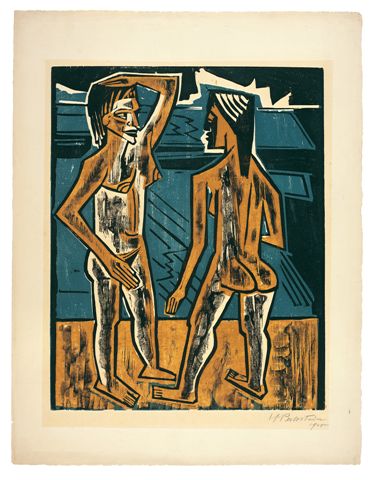
Effectively illustrated are the major themes that occupied the attention of these artists. One of these stemmed from a desire to create a pastoral Utopia – yearnings for the simple life that led members of Die Brücke to spend their summers together, either at the lakes, or in a remote fishing village in Eastern Prussia. Related to these expeditions are depictions of fishermen and studies of waves and sand dunes. And, in a fantastical vein, images of young nude girls cavorting in a sylvan landscape.
Primitive art with its strong lines and crude forms held a powerful attraction for all the German expressionists. Dialogue, a color woodcut of two angular nudes by Max Pechstein (who joined Die Brücke a year after its founding) a typical piece, drew inspiration from Gauguin, African and Oceanic art, and also Picasso. However, Pechstein did not simply glean his ideas from works seen in exhibitions or illustrations in books, but mined an original source, having lived for a time in the Palau Islands in the South Pacific.
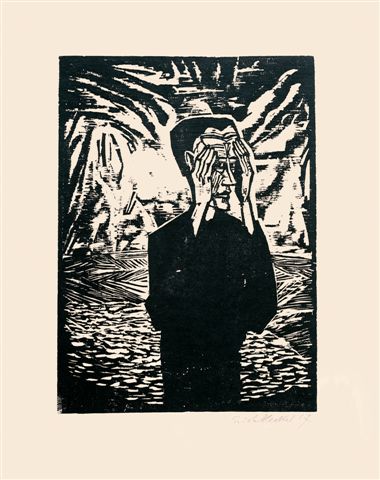
Portraits and self-portraits were another major theme. In these renderings, the artists or their models stare out at the world with quizzical, sorrowful or even defiant expressions on their faces. A powerful example is Man on a Plain, a black and white woodcut by Erich Heckel, an artist who served as a medical orderly at Flanders in the Second World War. In this disturbing image, a man, possibly Heckel himself, stands with his back to a chaotic landscape. His hands are raised to his face in a protective gesture, but his eyes, though shaded, look straight ahead.
One may ask what memory or scene haunts this man. Is it the horrors of war? Or is he just sickened by the corroded values of Big City life, a materialistic society intent on their own pleasures, indifferent to the suffering of others. As illustrated in this show, this was an extremely popular Expressionist theme for which the graphics arts proved the ideal vehicle for savage criticism.
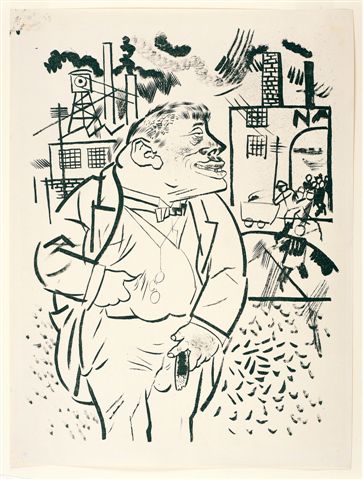
A set of nine prints by Georg Grosz executed in strong black outlines and exaggerated imagery to the point of the grotesque illustrates the text of Friedrich Schiller’s 1781 play The Robbers. This was a critical study of the immoral ‘lords’ of a city where the poor and weak were exploited and oppressed. In the first work in this series, Grosz depicts a fat, monstrous looking ‘industrialist’, cigar in hand. He stands in front of a factory where black smoke is belching from its chimneys. The workers are depicted as tiny insignificant figures with faces devoid of features.
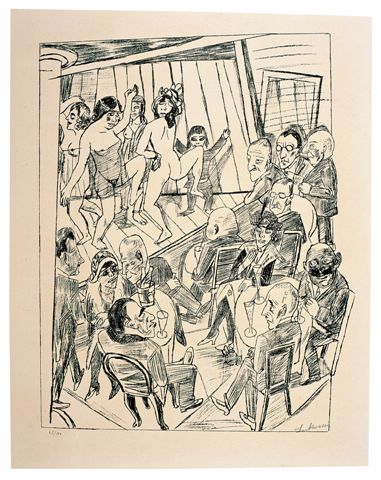
Max Beckmann, who was never associated with any artistic group but is widely acknowledged as one of Germany’s major artists of the 20th century, is represented in this selection by Trip to Berlin, one of his major print portfolios. Executed in 1922, four years after Germany’s defeat in World War I, Beckman shows the poor and the war-wounded begging on the streets while wealthy citizens while away their time in coffee shops and bars. In the tension –filled scene, titled Striptease, a troupe of ugly nude dancers perform on stage before an audience of mean looking characters.
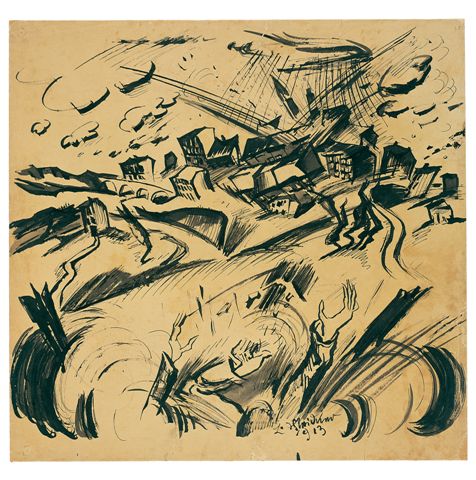
Ludwig Meidner, the founder, together with Jacob Steinhardt, of the Berlin Expressionist group known as Die Pathetiker, (The Suffering Ones), also made prints and drawings of urban night life. In his versions, skull faced people crowd into places of entertainment. But Meidner is best known for the visionary apocalyptic landscapes that he painted and drew. Explosion, is an example on display here. In this furious pencil and ink drawing from 1913 where buildings and landscape are caught up in a whirlwind of destruction, Meidner seemed to be anticipating the war to come.
This is an impressive overview, whetting one’s appetite for future shows in this gallery featuring the work of individual Expressionist artists in depth. One last point. No mention is made in the gallery texts of the fact that when the Nazis came to power, the work of most of these artists was vilified, and put on show in the notorious Entartete Kunst (“Degenerate Art”) exhibition of 1937, before being destroyed. .
Herta and Paul Amir Wing
Tel Aviv Museum of Art






A perceptive and insightful response to these immensely powerful artworks. The city of Leicester, England has the pre-eminent collection of German Expressionism in the UK, with works by Franz Marc, Kandinsky, Dix, Heckel, Kirchner, Munter, Beckmann, Feininger, Mueller,Felixmuller, Kollwitz and Grosz.
Best wishes,
Simon Lake, Curator of Art, New Walk Museum, Leicester.
Comments are closed.